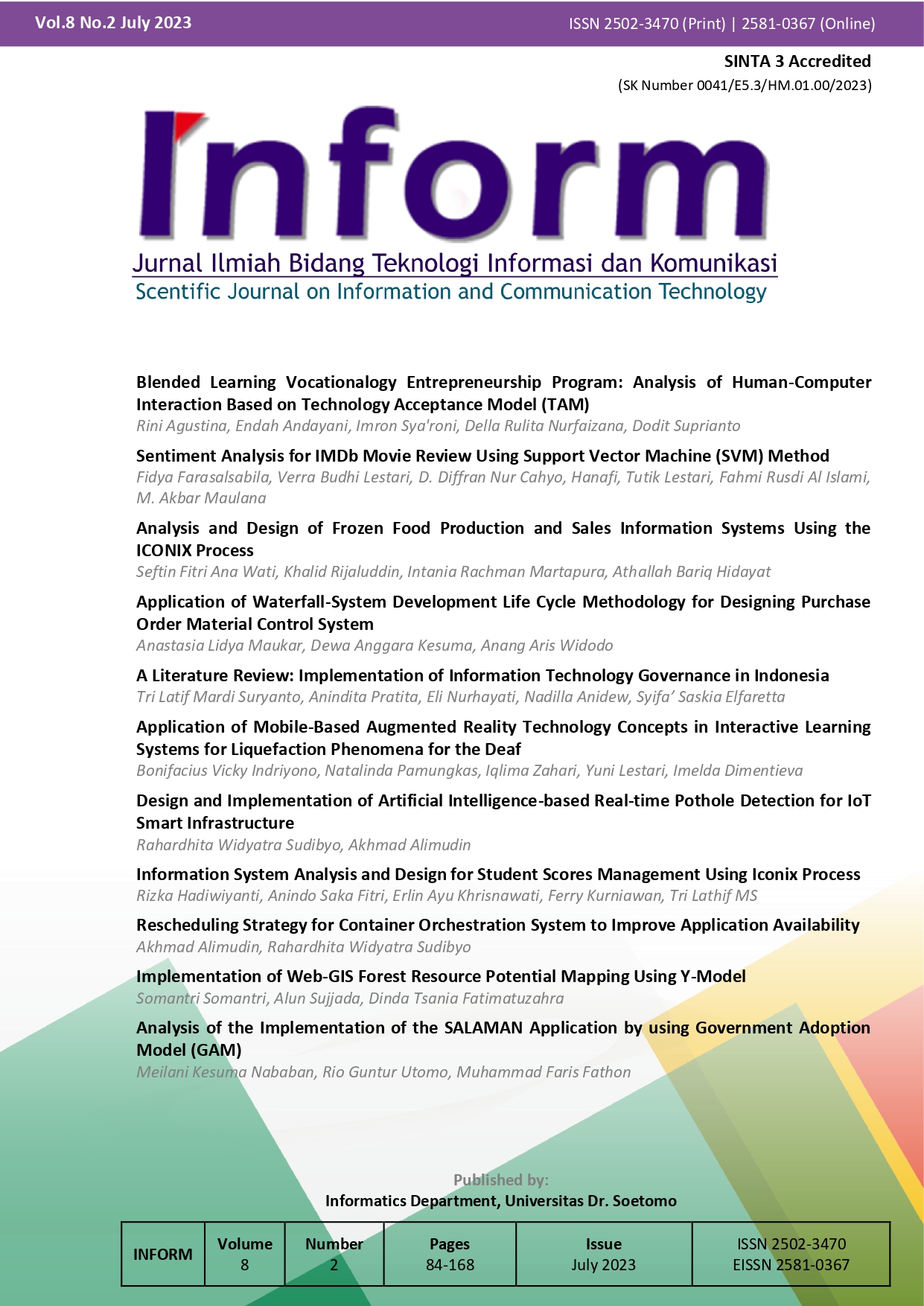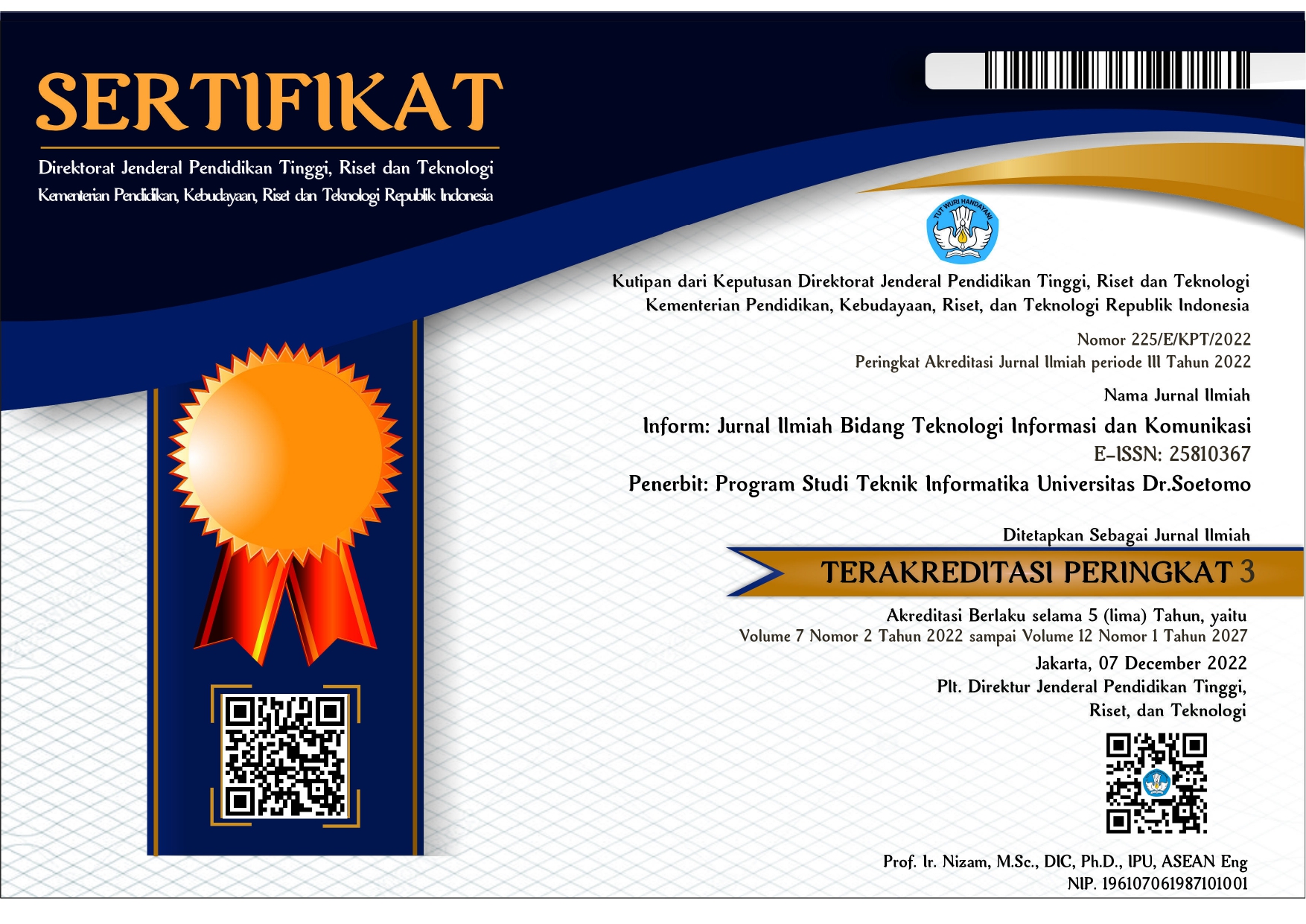Analysis of the Implementation of the SALAMAN Application by using Government Adoption Model (GAM)
 Abstract views: 378
,
Abstract views: 378
,
 PDF downloads: 185
PDF downloads: 185
Abstract
The city of Bandung is one of the cities that has implemented e-government in government affairs in Indonesia. The government launched an integrated service application called Done in the Hand (SALAMAN) to improve public services in Bandung. This application service will make it easier for residents and immigrant residents who want to take care of population administration in Bandung. However, the biggest obstacle to using this new system is coming from the community itself. This study aims to determine the level of public acceptance of the new system using the Government Adoption Model (GAM) method and then determine the variable factors that influence the level of acceptance of the E-government application in Bandung. Questionnaires were distributed via Google form to collect data from residents of Bandung, regardless of whether or not they used the application. Four hundred participants participated in the study, making up the sample size for this research endeavor. The method used for the data analysis is the Structural Equation Modelling Partial Least Square (SEM PLS). According to the study's findings, the degree to which the society approves of the application is proportional to the degree to which the application provides good value to the society of Bandung City. A good application assessment based on the application user's positive feedback shows the extent of community approval for e-government services. The percentage of an evaluation carried out using the GAM also depends on the respondents' answers to all of the variables, which, on average, yielded a score of 78.40%, meeting the "good" requirements. The implementation of the application shows that the higher users' positive feedbacks, the higher users' intention continue using the application.
References
J. Hochstetter, J. Díaz, M. Diéguez, R. Espinosa, J. A. López, and C. Cares, "Assessing Transparency in eGovernment Electronic Processes," IEEE Access, vol. 10, pp. 3074–3087, 2021, doi: 10.1109/ACCESS.2021.3137799.
A. Alkraiji and N. Ameen, "The Impact of Service Quality, Trust and Satisfaction on Young Citizen Loyalty Towards Government E-Services," Inf. Technol. People, vol. 35, no. 4, pp. 1239–1270, 2022, doi: 10.1108/ITP-04-2020-0229.
M. Nuraini, T. Husni, and F. Adrianto, “Pengaruh Inovasi Layanan Electronic Banking, Fee Based Income dan Efektivitas Pengendalian Internal terhadap Nilai Perusahaan Perbankan yang Terdaftar di Bursa Efek Indonesia,” J-MAS (Jurnal Manaj. dan Sains), vol. 7, no. 2, pp. 787–793, 2022, doi: 10.33087/jmas.v7i2.650.
R. ‘Arsy Elkesaki, R. D. Oktaviani, and M. P. Setyaherlambang, “Inovasi Pelayanan Publik Dinas Kependudukan dan Catatan Sipil di Kota Bandung,” J. Caraka Prabu, vol. 5, no. 1, pp. 69–90, 2021.
D. A. Damayanti, N. Y. Yuningsih, and I. Akbar, "Efektivitas Pelayanan Administrasi Kependudukan di Masa Peralihan Layanan Tahun 2021 di Kota Bandung," J. Adm. Pemerintah., vol. 2, no. 2, pp. 323–337, 2022, doi: 10.24198/janitra.v2i2.45169.
Disdukcapil, “Disdukcapil Kota Bandung Kembali Mengaktifkan Aplikasi Salaman,” Disdukcapil Kota Bandung, 2022. https://disdukcapil.bandung.go.id/berita-detail/disdukcapil-kota-bandung-kembali-mengaktifkan-aplikasi-salaman
A. Purwanto and T. D. Susanto, “Pengaruh Dimensi Kepercayaan Terhadap Adopsi Layanan E-Government,” Inf. J. Ilm. Bid. Teknol. Inf. dan Komun., vol. 3, no. 1, pp. 12–18, 2018, doi: 10.25139/ojsinf.v3i1.520.
D. Napitupulu, "Analysis of factors affecting the website quality based on WebQual approach (study case: XYZ University)," Int. J. Adv. Sci. Eng. Inf. Technol., vol. 7, no. 3, pp. 792–798, 2017, doi: 10.18517/ijaseit.7.3.1748.
H. Haryono, F. M. Amin, and N. Ulinnuha, "The E-Government Factors of Smart Mobility Success using DeLone McLean and E-Government Adoption Model," Informatics Secur., vol. 8, no. 2, pp. 87–99, 2023, doi: 10.33506/insect.v8i2.2210.
E. Setiawan, W. W. Winarno, and D. H. Fudholi, “Analisis Faktor Penerimaan Layanan e-Government dengan Menggunakan Model UTAUT2 dan GAM di Kabupaten Gunungkidul,” J. Media Inform. Budidarma, vol. 5, no. 1, pp. 34–41, 2021, doi: 10.30865/mib.v5i1.2565.
E. Sorongan, D. R. Sari, H. S. Kusno, and M. Zulfariansyah, "Can Satisfaction Interventions Rise Interest in E-Government Service Adoption in Indonesia? The Extended Perspective of The TAM Model,” JATISI (Jurnal Tek. Inform. dan Sist. Informasi), vol. 10, no. 1, pp. 620–634, 2023, doi: 10.35957/jatisi.v10i1.3388.
A. K. Darmawan, D. O. Siahaan, T. D. Susanto, M. Walid, B. A. Umam, and A. N. Hidayanto, "Identifying the Differing Service Maturity Levels of Mobile-Based Smart Regency with e-Government Adoption Model (GAM) Framework," in 2020 International Conference on ICT for Smart Society (ICISS), 2020, pp. 1–6. doi: 10.1109/ICISS50791.2020.9307540.
W. Munyoka, "Factors Influencing Digital Government Adoption in Zimbabwe," in 2019 Open Innovations (OI), 2019, pp. 262–267. doi: 10.1109/OI.2019.8908196.
L. Oktavia, “Penilaian Penerimaan E-Government Di Indonesia,” J. CoreIT, vol. 6, no. 1, pp. 15–21, 2020, doi: http://dx.doi.org/10.24014/coreit.v6i1.9143.
L. A. S. Dewi and Mudjahidin, “Analisis Penerapan Aplikasi Surabaya Single Windows Pemerintah Kota Surabaya Menggunakan Government Adoption Model (GAM),” J. Tek. POMITS, vol. 3, no. 2, p. 210=215, 2014, doi: 10.12962/j23373539.v3i2.8285.
H. A. Imron, “Peran Sampling dan Distribusi Data Dalam Penelitian Komunikasi Pendekatan Kuantitatif,” J. Stud. Komun. dan Media, vol. 21, no. 1, pp. 111–126, 2017, doi: 10.31445/jskm.2017.210109.
W. Budiaji, “Skala Pengukuran dan Jumlah Respon Skala Likert (The Measurement Scale and The Number of Responses in Likert Scale),” J. Ilmu Pertan. dan Perikan. Desember, vol. 2, no. 2, pp. 127–133, 2013, doi: 10.31227/osf.io/k7bgy.
J. F. Hair, J. J. Risher, M. Sarstedt, and C. M. Ringle, "When To Use And How To Report The Results of PLS-SEM," Eur. Bus. Rev., vol. 31, no. 1, pp. 2–24, 2019, doi: 10.1108/EBR-11-2018-0203.
J. L. G. Safitri and F. Oktafani, “Analisis Penerimaan Augmented Reality Pada Wardah Virtual Try On dengan Pendekatan Technology Acceptance Model (TAM),” SEIKO J. Manag. Bus., vol. 5, no. 2, pp. 490–503, 2022, doi: 10.37531/sejaman.v5i2.2367.
V. S. S. Sitio, “Analisis Faktor-Faktor yang Mempengaruhi Produktivitas Kerja Karyawan PT Bank Panin Dubai Syariah, Tbk Jabodetabek Selama Masa Pandemik Covid-19,” J. Ilm. M-PROGRESS, vol. 11, no. 2, pp. 125–135, 2021, doi: 10.35968/m-pu.v11i2.694.
Sukemi and T. Trisnawati, “Analisis Confirmatory Factor Analysis (CFA) Dan Exploratory Factor Analysis (EFA) Pada Pengembangan Instrumen Motivasi Belajar Sekolah Dasar,” Abacus Acad. J. Math. Learn. Educ., vol. 2, no. 2, pp. 1–8, 2021, [Online]. Available: https://jurnal.upg.ac.id/index.php/abacus/article/view/220
I. Ghozali and H. Latan, Partial Least Squares Konsep, Teknik Dan Aplikasi Menggunakan Program Smartpls 3.0 Untuk Penelitian Empiris. Semarang: Badan Penerbit UNDIP, 2015.
W. Abdillah and J. Hartono, Partial Least Square (PLS) Alternatif Structural Equation Model (SEM) dalam Penelitian Bisnis. Yogyakarta: Andi, 2019.
M. Nashar and Taru, “Pengaruh Lingkungan Kerja Dan Budaya Organisasi Terhadap Reputasi Perusahaan Dengan Komitmen Organisasi Sebagai Variabel Intervening (Studi Kasus Oada PT Petra Garda Paramita),” J. Appl. Bus. Adm. JABA, vol. 4, no. 2, pp. 156–162, 2020, doi: 10.30871/jaba.v4i2.2064.
C. M. Ringle, S. Wende, and J.-M. Becker, “SmartPLS 4: Model Fit,” Oststeinbek: SmartPLS, 2022. https://www.smartpls.com/documentation/algorithms-and-techniques/model-fit/
R. Bisma, “Faktor Adopsi Layanan E-government Jenis Layanan Transaksi,” J. Inf. Eng. Educ. Technol., vol. 1, no. 2, pp. 83–88, 2017, doi: https://doi.org/10.26740/jieet.v1n2.p83-88.
R. Widiyasari and B. N. Achadiyah, "Computer Anxiety, Computer Self-Efficacy dan Perceived Usefulness oleh Pelaku UMKM," J. Akunt. Aktual, vol. 6, no. 1, pp. 203–214, 2019, doi: 10.17977/um004v5i32019p203.
Y. Mangoting, “Perceived Risk, Perceived Functional Benefit, dan Kepuasan sebagai Penentu Intensi Berkelanjutan Wajib Pajak Menggunakan e-filing,” J. ASET (Akuntansi Riset), vol. 12, no. 1, 2020, doi: https://doi.org/10.17509/jaset.v12i1.22920.
T. P. U. Siwi and Z. Nawawi, "Building Citizen Satisfaction Towards E-Government Services: A Conceptual Framework," J. Manaj. Pelayanan Publik, vol. 6, no. 2, pp. 253–265, 2023, doi: 10.24198/jmpp.v6i2.46471.
Y. Muflihah and T. D. Susanto, “Faktor yang Mempengaruhi Warga dan Pemerintah dalam Adopsi E-Government: Sebuah Ulasan Sistematis,” J. Teknol. Inf. dan Ilmu Komput., vol. 4, no. 4, pp. 304–310, 2017, doi: 10.25126/jtiik.201744366.
Y. Suprapto and Farida, "Analisis Pengaruh Brand Image, Trust, Security, Perceived Usefulness, Perceived Ease Of Use Terhadap Adoption Intention Fintech Di Kota Batam," ournal Appl. Bus. Adm., vol. 6, no. 1, pp. 17–26, 2022, doi: 10.30871/jaba.v6i1.3396.
Sukendra, I. K., & Atmaja, I. (2020). Instrumen Penelitian. Lumajang: Mahameru Press
Shareef, M. A., Kumar, V., Kumar, U., & Dwivedi, Y. K. (2011). e-Government Adoption Model (GAM): Differing service maturity levels. Government information quarterly, 28(1), 17-35.
Copyright (c) 2023 Meilani Kesuma Nababan, Rio Guntur Utomo, Muhammad Faris Fathoni

This work is licensed under a Creative Commons Attribution-ShareAlike 4.0 International License.
Authors who publish with Inform: Jurnal Ilmiah Bidang Teknologi Informasi dan Komunikasi agree to the following terms:
-
Authors retain copyright and grant the journal right of first publication with the work simultaneously licensed under a Creative Commons Attribution License (CC BY-SA 4.0) that allows others to share the work with an acknowledgment of the work's authorship and initial publication in this journal.
-
Authors are able to enter into separate, additional contractual arrangements for the non-exclusive distribution of the journal's published version of the work (e.g., post it to an institutional repository or publish it in a book), with an acknowledgment of its initial publication in this journal.
-
Authors are permitted and encouraged to post their work online (e.g., in institutional repositories or on their website) prior to and during the submission process, as it can lead to productive exchanges, as well as earlier and greater citation of published work.











